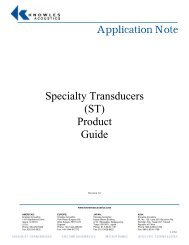16-Bit, Ultra-Low Power, Voltage Output Digital-to-Analog ... - dreamm
16-Bit, Ultra-Low Power, Voltage Output Digital-to-Analog ... - dreamm
16-Bit, Ultra-Low Power, Voltage Output Digital-to-Analog ... - dreamm
You also want an ePaper? Increase the reach of your titles
YUMPU automatically turns print PDFs into web optimized ePapers that Google loves.
DAC8830<br />
DAC8831<br />
SLAS449B–FEBRUARY 2005–REVISED APRIL 2006<br />
<strong>Output</strong> Amplifier Selection<br />
Reference and Ground<br />
<strong>Power</strong> Supply and Reference Bypassing<br />
www.ti.com<br />
For bipolar mode, a precision amplifier should be used, supplied from a dual power supply. This provides the<br />
±V REF output.<br />
In a single-supply application, selection of a suitable operational amplifier may be more difficult because the<br />
output swing of the amplifier does not usually include the negative rail; in this case, AGND. This output swing<br />
can result in some degradation of the specified performance unless the application does not use codes near 0.<br />
The selected operational amplifier needs <strong>to</strong> have low-offset voltage (the DAC LSB is 38 µV with a 2.5 V<br />
reference), eliminating the need for output offset trims. Input bias current should also be low because the bias<br />
current multiplied by the DAC output impedance (approximately 6.25 kΩ) adds <strong>to</strong> the zero-code error.<br />
Rail-<strong>to</strong>-rail input and output performance is required. For fast settling, the slew rate of the operational amplifier<br />
should not impede the settling time of the DAC. <strong>Output</strong> impedance of the DAC is constant and<br />
code-independent, but in order <strong>to</strong> minimize gain errors the input impedance of the output amplifier should be as<br />
high as possible. The amplifier should also have a 3 dB bandwidth of 1 MHz or greater. The amplifier adds<br />
another time constant <strong>to</strong> the system, thus increasing the settling time of the output. A higher 3 dB amplifier<br />
bandwidth results in a shorter effective settling time of the combined DAC and amplifier.<br />
Since the input impedance is code-dependent, the reference pin should be driven from a low impedance source.<br />
The DAC8830 and DAC8831 operate with a voltage reference ranging from 1.25V <strong>to</strong> V DD . References below<br />
1.25V result in reduced accuracy.<br />
The DAC full-scale output voltage is determined by the reference. Table 1 and Table 2 outline the analog output<br />
voltage for particular digital codes.<br />
For optimum performance, Kelvin sense connections are provided on the DAC8831. If the application does not<br />
require separate force and sense lines, they should be tied <strong>to</strong>gether close <strong>to</strong> the package <strong>to</strong> minimize voltage<br />
drops between the package leads and the internal die.<br />
For accurate high-resolution performance, it is recommended that the reference and supply pins be bypassed<br />
with a 10 µF tantalum capaci<strong>to</strong>r in parallel with a 0.1 µF ceramic capaci<strong>to</strong>r.<br />
20 Submit Documentation Feedback















